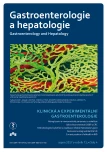Effect of nitroglycerin on high resolution manometry parameters in patients with achalasia
Authors:
Peter Bánovčin; Martin Ďuriček; Peter Lipták; R. Hyrdel
Authors‘ workplace:
Interná klinika gastroenterologická JLF UK a UN Martin, Slovenská republika
Published in:
Gastroent Hepatol 2017; 71(4): 287-292
Category:
Clinical and Experimental Gastroenterology: Original Article
doi:
https://doi.org/10.14735/amgh2017287
Overview
Nitroglycerin has long been used to relieve symptoms in patients with achalasia. It is well known that nitroglycerin decreases the pressure of the lower esophageal sphincter via mechanisms involving the production of nitric oxide. High resolution manometry (HRM) with esophageal pressure topography provides a more robust and sensitive evaluation of esophageal function, which allows better quantification. However, the effects of nitroglycerin on esophageal function have not yet been quantified using HRM. For example, the effects of nitroglycerin on upper esophageal sphincter in patients with achalasia have not been defined.
Aims and Methods:
The aim of the study was to quantify the effect of nitroglycerin on selected HRM parameters in patients with achalasia. We performed HRM in 15 consecutive patients with achalasia. We quantified the effects of nitroglycerine on esophageal function in patients with achalasia by using HRM measurements according to Chicago criteria. HRM analysis revealed that in patients with achalasia nitroglycerin affects not only the lower esophageal sphincter, but also influences the function of the upper esophageal sphincter. Nitroglycerin challenge may be a useful tool for future motility studies in patients with achalasia.
Key words:
achalasia – nitroglycerin – high resolution manometry – esophagus
The authors declare they have no potential conflicts of interest concerning drugs, products, or services used in the study.
The Editorial Board declares that the manuscript met the ICMJE „uniform requirements“ for biomedical papers.
Submitted:
12.6.2017
Accepted:
8.7.2017
Sources
1. Sadowski DC, Ackah F, Jiang B et al. Achalasia: incidence, prevalence and survival. A population-based study. Neurogastroenterol Motil 2010; 22 (9): e256–e261. doi: 10.1111/j.1365-2982.2010.01511.x.
2. Birgisson S, Galinski MS, Goldblum JR et al. Achalasia is not associated with measles or known herpes and human papilloma viruses. Dig Dis Sci 1997; 42 (2): 300–306.
3. Facco M, Brun P, Baesso I et al. T cells in the myenteric plexus of achalasia patients show a skewed TCR repertoire and react to HSV-1 antigens. Am J Gastroenterol 2008; 103 (7): 1598–1609. doi: 10.1111/j.1572-0241.2008.01956.x.
4. Verne GN, Hahn AB, Pineau BC et al. Association of HLA-DR and -DQ alleles with idiopathic achalasia. Gastroenterology 1999; 117 (1): 26–31.
5. Vackova Z, Niebisch S, Becker J et al. Association of the HLA-DQB1-insertion in Idiopathic Achalasia and First Genotype-Phenotype (GxP) Study Using High-Resolution Manometry Data. Gastroenterology 2016; 150 (4): S58. doi: 10.1016/S0016-5085 (16) 30315-8.
6. Kahrilas PJ, Bredenoord AJ, Fox M et al. The Chicago Classification of esophageal motility disorders, v3.0. Neurogastroenterol Motil 2015; 27 (2): 160–174. doi: 10.1111/nmo.12477.
7. Ďuriček M, Bánovčin P, Hyrdel R. Poruchy motility pažeráka – Chicagska klasifikácia. Gastroent Hepatol 2015; 69 (2): 130–138. doi: 10.14735/amgh2015130.
8. Martínek J, Široký M, Plottová Z et al. Treatment of patients with achalasia with botulinum toxin: a multicenter prospective cohort study. Dis Esophagus 2003; 16 (3): 204–209. doi: 10.1046/j.1442-2050.2003.00329.x.
9. Halicka J, Banovcin P Jr, Halickova M et al. Acid infusion into the esophagus increases the number of meal-induced transient lower esophageal sphincter relaxations (TLESRs) in healthy volunteers. Neurogastroenterol Motil 2014; 26 (10): 1469–1476. doi: 10.1111/nmo.12409.
10. Annese V, Bassotti G. Non-surgical treatment of esophageal achalasia. World J Gastroenterol 2006; 12 (36): 5763–5766.
11. De Giorgio R, Di Simone MP, Stanghellini V et al. Esophageal and gastric nitric oxide synthesizing innervation in primary achalasia. Am J Gastroenterol 1999; 94 (9): 2357–2362.
12. Bortolotti M, Mari C, Lopilato C et al. Effects of sildenafil on esophageal motility of patients with idiopathic achalasia. Gastroenterology 2000; 118 (2): 253–257.
13. Gelfond M, Rozen P, Keren S et al. Effect of nitrates on LOS pressure in achalasia: a potential therapeutic aid. Gut 1981; 22 (4): 312–318.
14. Gelfond M, Rozen P, Gilat T. Isosorbide dinitrate and nifedipine treatment of achalasia: a clinical, manometric and radionuclide evaluation. Gastroenterology 1982; 83 (5): 963–969.
15. Rozen P, Gelfond M, Zaltzman S et al. Dynamic, diagnostic, and pharmacological radionuclide studies of the esophagus in achalasia. Radiology 1982; 144 (3): 587–590.
16. Wong RK, Maydonovitch C, Garcia JE et al. The effect of terbutaline sulfate, nitroglycerin, and aminophylline on lower esophageal sphincter pressure and radionuclide esophageal emptying in patients with achalasia. J Clin Gastroenterol 1987; 9 (4): 386–389.
17. Wen ZH, Gardener E, Wang YP. Nitrates for achalasia. Cochrane Database Syst Rev 2004; 1: CD002299.
18. Roman S, Huot L, Zerbib F et al. High-Resolution Manometry Improves the Diagnosis of Esophageal Motility Disorders in Patients With Dysphagia: A Randomized Multicenter Study. Am J Gastroenterol 2016; 111 (3): 372–380. doi: 10.1038/ajg.2016.1.
19. Kahrilas PJ, Boeckxstaens G. The spectrum of achalasia: lessons from studies of pathophysiology and high-resolution manometry. Gastroenterology 2013; 145 (5): 954–965. doi: 10.1053/j.gastro. 2013.08.038.
20. Yoneyama F, Miyachi M, Nimura Y. Manometric findings of the upper esophageal sphincter in esophageal achalasia. World J Surg 1998; 22 (10): 1043–1046.
21. DeVault KR. Incomplete upper esophageal sphincter relaxation: association with achalasia but not other esophageal motility disorders. Dysphagia 1997; 12 (3): 157–160.
22. Mathews SC, Ciarleglio M, Chavez YH et al. Upper esophageal sphincter abnormalities are strongly predictive of treatment response in patients with achalasia. World J Clin Cases 2014; 2 (9): 448–454. doi: 10.12998/wjcc.v2.i9.448.
23. Chavez YH, Ciarleglio MM, Clarke JO et al. Upper esophageal sphincter abnormalities: frequent finding on high-resolution esophageal manometry and associated with poorer treatment response in achalasia. J Clin Gastroenterol 2015; 49 (1): 17–23. doi: 10.1097/MCG.0000000000000 157.
Labels
Paediatric gastroenterology Gastroenterology and hepatology SurgeryArticle was published in
Gastroenterology and Hepatology

2017 Issue 4
Most read in this issue
- Outcome of treatment of Helicobacter pylori infection based on microbiological susceptibility testing following the unsuccessful second-line eradication treatment
- Acute appendicitis – a rare complication of colonoscopy
- Self-expandable coated metal Danis stent as a bridge to liver transplantation
- Graft-duodenal fistula – a cause of massive gastrointestinal bleeding
